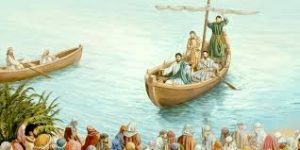The Public Parables of the Kingdom by the Sea
Matthew 13:1-3a; Mark 4:1-2; Luke 8:4

The parables that Jesus taught the masses by the sea were to hide the Kingdom from those who lacked faith, and to reveal the Kingdom to those who believed. The Lord declared: To those who have ears, let them hear. Those who trusted in Christ had spiritual ears to not only hear, but to understand what He was saying. The same day that Messiah was rejected by the Sanhedrin, He went out and sat by the Sea of Galilee. After spending some time teaching His talmidim, our Lord resumed His wider ministry among the people at various points along the seashore. The crowds were greater than ever. Such large crowds gathered around Him that He got into a boat and sat in it, while all the people stood on the shore. Mark’s source is generally conceded to be Peter, who was a fisherman and owned two types of boats: a rowboat that He kept ready for a quick escape from large crowds that might crush Him and a larger boat moored close to the shore where He sat and taught them many things in parables (Matthew 13:1-3a; Mark 4:1-2; Luke 8:4).
Christ spoke everything to them in parables. With a narrow strip of water between Himself and the large crowds, Yeshua taught them. The acoustics on a lakeshore are excellent. One can hear and understand someone’s voice from quite a distance. He did not say anything to them without using a parable. So was fulfilled what was spoken through the prophet Isaiah when he said: I will open My mouth in parables, I will utter things hidden since the creation of the world (Mattityahu 13:34-35). He taught them. The verb taught is in the imperfect tense, speaking of continuous action. Even though our Lord’s words often fell on dull ears, hard hearts and unresponsive wills, He taught them.
After the introductory Parable of the Soils, there are four other couplets of parables. Two of those couplets were given by the Sea of Galilee to the Twelve and the crowd made up of believers and unbelievers. The first couplet is comprised of the parables of the Seed Growing by Itself (true) and the Wheat and the Weeds (false), which demonstrate a true planting will be imitated by a false counter-planting. The second couplet is made up of the parables of the Mustard Seed (external) and the Leaven (internal), where we see the corruption of the visible church.



Leave A Comment